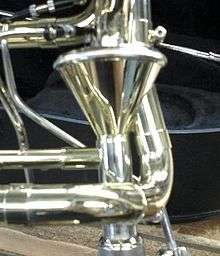Axial flow valve
The Thayer Axial-Flow Valve is a replacement for the traditional rotary valve found on trombones with F attachments. Invented by Orla Ed Thayer (with assistance from Zig Kanstul) in 1976, it was the biggest advance in the design of the trombone since the rotary valve was added (creating the F attachment) in the mid-19th century. The valve was the subject of a protracted legal battle between Orla Ed Thayer and James Nydigger, an early business partner. A U.S. patent No. 4,469,002 was filed in May 1982 and issued in September 1984, and is now expired. Orla Ed Thayer died on June 3, 2009, at the age of 89.

Problem
When engaged, a rotary valve deflects the air flow through the instrument at least four times, and at least twice at rather sharp angles, leading to a stuffy response and audible tone colour changes, compared to the "open" instrument.
These drawbacks are especially severe with the trombone, because the instrument's characteristic timbre is a direct result of its construction, which is mostly completely straight: Apart from any possible valve tubing, there are only two bends, and the bore is almost completely cylindrical.
In contrast, the softer sound of "horn-like" brass instruments, so readily distinguishable from that of the trombone, is at least partially a result of their more or less conical bore and their intricate construction with many bows and bends.
The change in timbre and response was made even more severe by the traditional wrap of the valve tubing in narrow curves between bell and gooseneck that was the norm until the 1980s.
Solution
The Thayer Valve uses a conical plug, allowing a deflection of the airflow by only 25 degrees or less. This also lets a smoother wrap of the F attachment's tubing (open wrap) become far more efficient. As a result, the response and tone colour are nearly unchanged from those of the open instrument, even for twin-valve bass trombones using the in-line configuration. Some trombonists even describe instruments whose response they experienced to be "more free-blowing" with the valves engaged.
Criticism
Some trombonists, as well as servicing craftspeople, claim the Thayer valve has higher cleaning and maintenance requirements, sometimes to the degree of impaired reliability. Others attribute these problems not to the valve's construction but to a lack of expertise on the part of the critics.
Some trombonists, especially bass players, claim that more resistance enhances the response of low notes on the valve side (below E♭). This group finds playing more modern designs to be more of a strain and also sometimes criticizes their tone, which they find "less warm".
("Open wrap" designs are sometimes criticized because the valve tubing is more exposed and thus less well protected when compared to traditional designs. This, however, is not a complaint specific to the Thayer valve as it may also be employed with other valve types.)
Aftermath
The Thayer Valve kicked off an "arms race" among trombone designers and manufacturers that continues today. Newer valves (Hagmann, Lätzsch-FullFlow, Greenhoe, Bosc, the Kanstul "Controlled Resistance" valve, Balanced Valve System, Millervalve, among others) have become the de facto standard, at least in the upper price range and among symphonic trombonists where consistent timbre is a highly prized attribute.